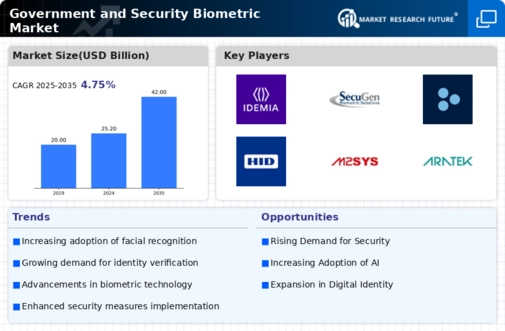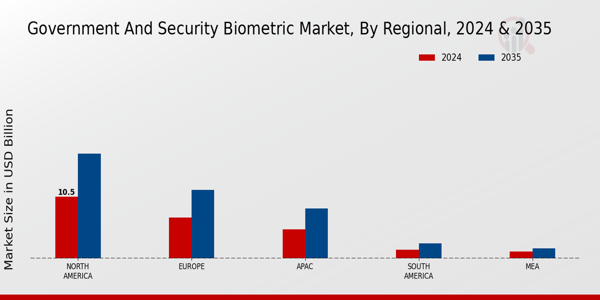Market Growth Projections
The Global Government and Security Biometric Market Industry is poised for substantial growth, with projections indicating a rise from 25.2 USD Billion in 2024 to 42 USD Billion by 2035. This growth trajectory suggests a compound annual growth rate (CAGR) of 4.75% from 2025 to 2035. The increasing adoption of biometric technologies across various sectors, including law enforcement, immigration, and public safety, is a driving force behind this expansion. As governments recognize the potential of biometric systems to enhance security and operational efficiency, investments in these technologies are expected to surge, further solidifying the market's growth potential.
Technological Advancements
Rapid technological advancements play a pivotal role in shaping the Global Government and Security Biometric Market Industry. Innovations in biometric modalities, such as facial recognition, fingerprint scanning, and iris recognition, enhance the accuracy and efficiency of identification processes. Governments are increasingly investing in these technologies to streamline operations and improve security measures. The anticipated growth from 25.2 USD Billion in 2024 to 42 USD Billion by 2035 indicates a robust demand for cutting-edge biometric solutions. Furthermore, the integration of artificial intelligence and machine learning in biometric systems is expected to refine data processing capabilities, thereby bolstering the overall effectiveness of security protocols.
Public Acceptance and Trust
Public acceptance and trust in biometric technologies are crucial for the expansion of the Global Government and Security Biometric Market Industry. As citizens become more familiar with biometric systems, their willingness to adopt these technologies increases. Governments are actively engaging in public awareness campaigns to educate citizens about the benefits and security of biometric identification. This growing acceptance is likely to drive market growth, as evidenced by the projected increase from 25.2 USD Billion in 2024 to 42 USD Billion by 2035. Enhanced transparency and the demonstration of effective use cases can further bolster public confidence, facilitating broader implementation of biometric solutions.
Increasing Security Concerns
The Global Government and Security Biometric Market Industry is driven by escalating security concerns across nations. Governments are increasingly adopting biometric systems to enhance national security and public safety. For instance, the implementation of biometric identification in border control and law enforcement has become prevalent. In 2024, the market is projected to reach 25.2 USD Billion, reflecting the urgency for advanced security measures. This trend is likely to continue as threats evolve, necessitating more sophisticated biometric solutions. The integration of biometric technology in various sectors, including airports and public facilities, further underscores its importance in addressing security challenges.
Regulatory Frameworks and Compliance
The establishment of stringent regulatory frameworks significantly influences the Global Government and Security Biometric Market Industry. Governments worldwide are enacting laws and guidelines to ensure the secure use of biometric data, thereby fostering trust among citizens. Compliance with these regulations is essential for organizations implementing biometric systems. As a result, the market is likely to witness growth driven by the need for compliant solutions. The projected CAGR of 4.75% from 2025 to 2035 suggests that as regulations evolve, the demand for secure and compliant biometric technologies will increase, prompting governments to invest in systems that align with legal requirements.
Globalization and Cross-Border Initiatives
Globalization and cross-border initiatives significantly impact the Global Government and Security Biometric Market Industry. As international travel and trade increase, governments are compelled to adopt biometric solutions to streamline processes and enhance security at borders. Collaborative efforts among nations to share biometric data for security purposes are becoming more common. This trend is likely to drive market growth, as countries seek to implement interoperable biometric systems. The anticipated CAGR of 4.75% from 2025 to 2035 reflects the increasing emphasis on global cooperation in security measures. Consequently, the demand for advanced biometric technologies that facilitate seamless cross-border identification is expected to rise.
















